Permanent link to this article: http://www.matthewbroomhead.co.uk/a-proud-podcast/
3 rules once you have joined a non-profit board/committee
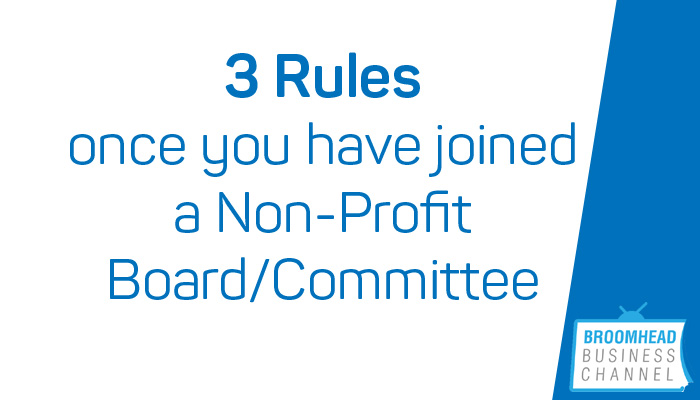 Here are my three rules for a more successful start once you have joined a non-profit board/committee:
Here are my three rules for a more successful start once you have joined a non-profit board/committee:
- Sit down with everyone on the committee for a one to one as soon as possible and ask what is important to them. Find out how you can help them. Are there articles or other things of value that you can share with them? Make introductions to your contacts when you think there will be a mutual fit.
- Volunteer to get involved as soon as possible and take on responsibility to prove you can be trusted.
- Understand the dynamics and politics of the group. For example avoid annoying the leadership by telling them what to do or trying to implement ideas before getting buy-in.
Matthew Broomhead
Permanent link to this article: http://www.matthewbroomhead.co.uk/3-rules-once-you-have-joined-a-nonprofit/
3 Rules for picking the right Non-Profit Board/Committee
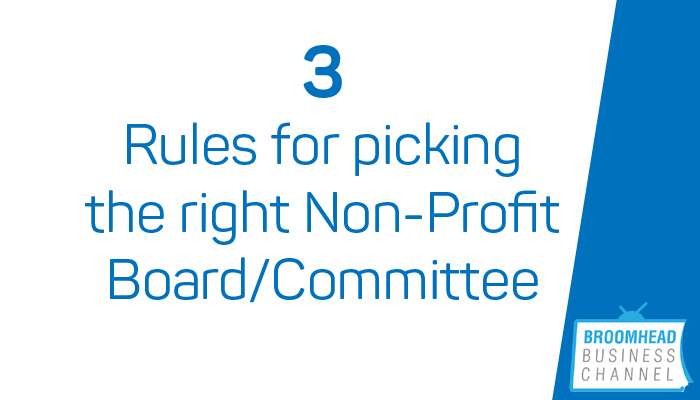
If you want to use your valuable skill set to help others and you decide to join a non-profit board or committee, then here are my three rules for picking the right one for you:
- Join something you believe in and resonates with your values. Don’t join something just because someone asks you.
- Find out from the current Chair what their personal values are and what direction they want to take the board and how they will serve their members/service users. How ambitious are they? Do the people they serve actually like them? To get an initial insight into the values of the Chair you could explore the demographics of the other board members. For example, you may check and see that out of twelve members there is only one man and he is obliged to be on there. Also the recent members joining are woman and previously resigned members were women, then there is certainly a hint of the type of people that are attracted to apply to be on the board and who are accepted. This goes for any demographic. However, the more diverse the board, the more inclusive and creative the Chair is.
- Does the board/committee need the skills you have and what will you get out of it? To some this may seem selfish, but it is not. When you are giving your precious time and skills voluntarily you need to ensure you have the same vision moving forward so that you will stay self-motivated.
Matthew Broomhead
Permanent link to this article: http://www.matthewbroomhead.co.uk/3-rules-for-picking-the-right-non-profit-board-committee/
7 Questions to ask ourselves after every Presentation
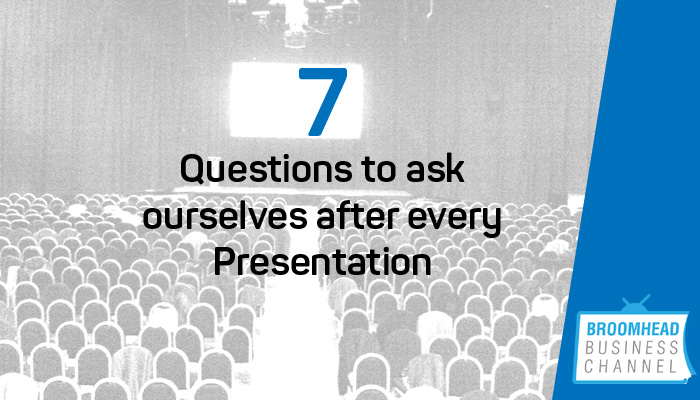 Most people that speak publicly want to improve their skills and the impact they have when they resonant with their audience. And yet some people after a presentation do not even review.
Most people that speak publicly want to improve their skills and the impact they have when they resonant with their audience. And yet some people after a presentation do not even review.
Those that do review, tend to be superficial so as to keep their ego intact. However, if you are reading my blog then you want more from the work that you do and the influence you have.
If we have gone to all the effort to speak publicly in front of a group of people and overcome our fear (that is greater than the fear of death for many of us), then why wouldn’t we want to ensure that the next time we do it, it will be even better?
By giving your audience a sense of belonging and a sense of purpose through the words, images and stories you convey then you are helping them create greater security and more likely to generate the change that you want.
To assist you, I have come up with these seven questions to ask yourselves after any public presentation. The first three generic questions were acquired from an excellent Frank Daniels coaching course I attended years ago. The other four questions were added to help one of my team that I had excitedly seen present at the Birmingham Conservatoire. I trust they will be as beneficial to you as they were to him.
If we are willing to delve into these questions in depth, then we can expect to rapidly develop our future presentations.
So what are the seven questions to ask ourselves after a presentation?
- What went well?
- What could have gone better?
- What will I do differently next time to make it even better?
- Why did I give the presentation? (include what Values it met)
- What did I hope the listener would do at the end of the presentation? The Desired Outcome.
- What evidence is there that they took action towards the Desired Outcome (how did/could I measure the outcome)?
- What is the next step in building the relationship with members of my audience?
Matthew Broomhead
Permanent link to this article: http://www.matthewbroomhead.co.uk/7-questions-to-ask-ourselves-after-every-presentation/
10 of 10 : Public Speaking – The speaker paces up and down like a caged animal
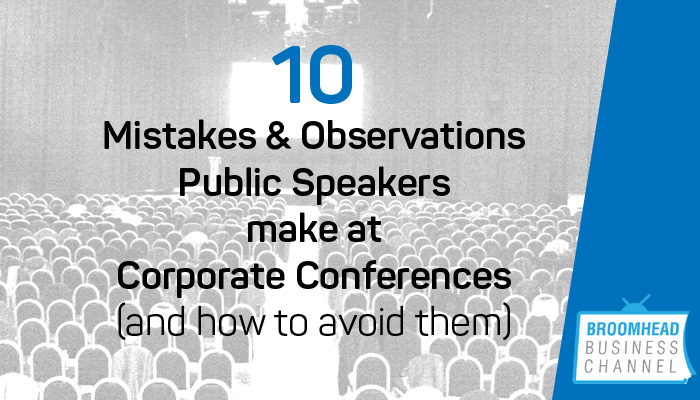 Mistakes & Observations Public Speakers make at Corporate Conferences
Mistakes & Observations Public Speakers make at Corporate Conferences
(and how to avoid them) cont… part 10 of 10
It helps most speaker’s brain work better to move around, however it does not help the audience.
Even though it can look a little odd, it is usually better to stand completely still than pace up and down creating a metaphorical “groove in the stage”.
Confident speakers intentionally move around the full width of the stage area to engage as much of the audience as possible. John C Maxwell has sat on the edge of the stage to “have a chat” with the audience. I have seen Allan Pease “walk around” an audience of over 3000 to get three volunteers.
Advanced Tip:
Expert speakers consciously use the large stage area and “position” [sometimes referred to as “anchor”] their ideas, message and key points to specific sections of the stage. If required, they also consider visually creating a timeline of “past, present and future” across the stage.
This is just the start..
I trust this ten part series on Public Speaking tips at Conferences will help to reduce your Public Speaking Anxiety. It will ensure your values, ethics and the vision you want to implement are enhanced instead of being hindered by very simple avoidable mistakes.
I obviously can help leaders with more than these ten mistakes, so if you want to raise your game to the next level then get some external professional help. Just practising your presentation by yourself will not make it outstanding. Whether you hire me or someone else doesn’t matter. But what does matter is the impact you have as a Leader, the positive change you want to make in your organisation and the team you inspire.
If you want to ensure your next presentation is better than anyone expected, then feel free to get in contact via LinkedIn or this website by clicking on “Message Matt” in the main menu and complete the Contact Form and I will get back in touch so we can have a chat about how I can help.
Matthew Broomhead
Permanent link to this article: http://www.matthewbroomhead.co.uk/10-of-10-public-speaking-the-speaker-paces-up-and-down-like-a-caged-animal/
9 of 10 : Public Speaking – Not all speakers appreciate the power of Stories
 Mistakes & Observations Public Speakers make at Corporate Conferences
Mistakes & Observations Public Speakers make at Corporate Conferences
(and how to avoid them) cont… Part 9 of 10
For thousands of years people have successfully passed on their values, ethics, and knowledge through stories. Long before most people could read and write, they shared stories.
Even though a corporate message needs to be very clear, if you want it to resonate with people, then a story can help bypass the logical part of our brain and embed new ways of thinking.
Matthew Broomhead
Permanent link to this article: http://www.matthewbroomhead.co.uk/9-of-10-public-speaking-not-all-speakers-appreciate-the-power-of-stories/
8 of 10 : Public Speaking -They don’t create a “hook” to get the audience on the edge of their seats

Mistakes & Observations Public Speakers make at Corporate Conferences
(and how to avoid them) cont… part 8 of 10
When we listen to a presentation we are constantly looking and listening for something called “closure”. Once someone thinks they know the “punchline”, then their attention will significantly reduce.
How do we prevent people switching off prematurely?
You may have noticed TV News Anchors constantly use “hooks” to draw in the viewer and keep them watching. This is a rather silly fictional example, but it is to get the concept across so you will understand the idea and be able to use it yourself with appropriate material:
“Later in the programme we discover how Eric the giraffe managed to get his head stuck in a very unusual place, but before that, Teresa May and how she will make a success of Brexit.”
Most people will listen to the first part of the news programme about Teresa May, to get the “closure” of what actually happened to Eric the Giraffe.
This technique enables us to include important, but less “interesting” items in our presentations and still keep the full attention of the audience.
When creating our own intrigue hooks to keep regaining the audience’s attention during our presentation, we must be truthful when explaining “what is coming up next”. We also need to create enough intrigue to have the audience sitting on the edge of their seats.
So what could you say that will get your audiences sitting on the edge of their seats?
Matthew Broomhead
Permanent link to this article: http://www.matthewbroomhead.co.uk/8-of-10-public-speaking-they-dont-create-an-hook-to-get-the-audience-on-the-edge-of-their-seats/
7 of 10 : Public Speaking – They don’t use influencing language to link their message to everyday tasks
Mistakes & Observations Public Speakers make at Corporate Conferences
(and how to avoid them) cont… part 7 of 10
I am just curious, how many members of your team take action after your presentation in the weeks following the event? Would you like it to be more?
In order to create subtle reminders to take action (with regards to what you have said) during the week after the event, once the motivation and hype of the event has gone, then you may want to take a look at some of these examples of typical phrases to use:
Whatever we say will influence someone else. To what extent and how, is dependent on many things including what words we say and how we say it.
“As you leave today and travel home safely, I want you to think about/remember this…”
“Maybe the next time you are sitting in a car waiting for the traffic lights to change to green…you are going to remember X”
“Perhaps the next time you are standing boiling a kettle for a hot drink…”
So to clarify, initially we state a generic scenario most audience members will be familiar with and are likely to experience in the near future. Then we add in the suggestion of what we would like the listener to think and do.
This is utilising how our brains work naturally and how to ensure the excellent ideas we are sharing are been put into practice, once our team get back into the day to day running of their jobs.
Matthew Broomhead
Permanent link to this article: http://www.matthewbroomhead.co.uk/7-of-10-public-speaking-they-dont-use-influencing-language-to-link-their-message-to-everyday-tasks/
6 of 10 : Public Speaking – The audience are slow to react because they are asked the wrong questions
 Mistakes & Observations Public Speakers make at Corporate Conferences
Mistakes & Observations Public Speakers make at Corporate Conferences
(and how to avoid them) cont… part 6 of 10
Sometimes directly asking an audience “Do you like the new announcements?” or “What do you think of the new announcements?” can get mixed responses.
They are not particularly unhelpful questions in themselves, but when speaking to a large audience then there is the potential for different reactions.
As an audience, they have a “role” primarily to “listen”. Therefore it can take time to get an answer. An audience (particularly a British one) need a little notice that you want them to respond and that you are “giving them permission” to react and make a noise. If you do not warn them, then you will get a quieter response, which can potentially embarrass the speaker. It can turn into a pantomime style of interaction of “I can’t hear you..!?” Group dynamics could also have a negative influence by people thinking to themselves “oh wow, that sounds good”, but then that message being undermined by a weak audience response.
At the start of the event the host introducing the idea of being excited and cheering when hearing announcements is standard practice. I would also recommend each speaker doing it themselves so that the audience know what they want them to do.
To reduce the likelihood of a weak response then consider being as blunt as saying something like these phrases:
“In a moment I am going to ask you a question to hear what you think/how you feel about it, but before that…”
“Let me ask you this…”
“Would it be ok if I ask for your response to something?…”
Are you ok with your next presentation just being good?
I have seen highly paid senior management people such as the CEO, Executive Chair and non-exec Directors, as well as first time on stage speakers make these common mistakes. Hence, now we have explored six of the ten main mistakes that public speakers make, if you want to ensure your next presentation is better than anyone expected, then feel free to get in contact via LinkedIn or this website by clicking on “Message Matt” menu and complete the Contact Form and I will get back in touch so we can speak.
Helping the best become better.
Matthew Broomhead
Permanent link to this article: http://www.matthewbroomhead.co.uk/6-of-10-public-speaking-the-audience-are-slow-to-react-because-they-are-asked-the-wrong-questions/
5 of 10 : Public Speaking – They don’t create enough emotion.
 Mistakes & Observations Public Speakers make at Corporate Conferences
Mistakes & Observations Public Speakers make at Corporate Conferences
(and how to avoid them) cont… part 5 of 10
There’s an old saying that emotion creates motion. We don’t really make decisions logically they are usually absorbed into our minds and bodies through emotion.
In a corporate environment this has to be appropriate. But if it’s too formal, shiny and missing a heart, then the change required won’t stay with the listeners.
Remember that as the speaker if you feel the emotion, whether it is confident, relaxed or excited then the audience are more likely to feel it too. Lead the audience.
Matthew Broomhead
Permanent link to this article: http://www.matthewbroomhead.co.uk/5-of-10-public-speaking-they-dont-create-enough-emotion/
4 of 10 : Public Speaking – Talk too much about what it means for them and not benefits to the audience.
 Mistakes & Observations Public Speakers make at Corporate Conferences
Mistakes & Observations Public Speakers make at Corporate Conferences
(and how to avoid them) cont… part 4 of 10
“WIIFM” (What’s In It For Me) is a common expression used in Marketing, and public speaking. Putting yourself in the shoes of the audience creates rapport and gets them onside much quicker and therefore ready to receive the message and make the mental and emotional changes required.
Matthew Broomhead
Permanent link to this article: http://www.matthewbroomhead.co.uk/4-of-10-public-speaking-talk-too-much-about-what-it-means-for-them-and-not-benefits-to-the-audience/
3 of 10 : Public Speaking – The magic of 3. How to make it easier for people to remember the message
 Mistakes & Observations Public Speakers make at Corporate Conferences
Mistakes & Observations Public Speakers make at Corporate Conferences
(and how to avoid them) cont… part 3 of 10
Overcomplicating things is a mistake most public speakers can make, so to counteract it, then consider using “the magic of 3”.
For generations the number three seems to have significance throughout human evolution, including in mythology and architecture. However long a talk (or event) is, then ensure it fits into three distinct parts. Two points is too few and more than three starts to get harder for an audience to remember.
Matthew Broomhead
Permanent link to this article: http://www.matthewbroomhead.co.uk/3-of-10-public-speaking-the-magic-of-3-how-to-make-it-easier-for-people-to-remember-the-message/
2 of 10 : Public Speaking – They don’t practice their hand gestures to add depth to their message.
 Mistakes & Observations Public Speakers make at Corporate Conferences
Mistakes & Observations Public Speakers make at Corporate Conferences
(and how to avoid them) cont… part 2 of 10
Only a few speakers get hand gestures right, but we can all practice to be better. Often gestures distract from the message instead of adding. Ideally gestures should be helping the audience visualise what we are explaining. They are supposed to be the brushes painting a picture in the minds-eye of the audience.
When we get nervous we tend to fidget, consequently it may be best to sometimes keep our hands fairly still and just use them when highlighting a significant point. It is a good idea to practice them, so they feel natural.
Big is better
In addition to actually using hand gestures to add to our message, we also need to be aware that the stage environment is different at a large conference. With large audiences of over 1000 delegates, speakers on stage will appear quite small to most of the audience. Hence use appropriate big gestures to fill the space around you particularly at the start and end. They have to be comfortable to your personality. It’s not enough to rely on the big video screens and close ups from video cameras.
Make sure you remember to “reverse”
As a final quick note on gestures, few people remember (or even know) that they should reverse their gestures for the audience. Moving your hands from left to right (i.e. when demonstrating progressing forward) is opposite to your audience. “Their” left to right is actually “your” right to left. It is another simple change that most people will not notice consciously, but they will understand your message more easily because you will be creating more rapport with them.
Matthew Broomhead
Permanent link to this article: http://www.matthewbroomhead.co.uk/2-of-10-public-speaking-they-dont-practice-their-hand-gestures-to-add-depth-to-their-message/
1 of 10 : Public Speaking – Poor Audience Response due to not having a Clear Ending to their Talk.
 Mistakes & Observations Public Speakers make at Corporate Conferences
Mistakes & Observations Public Speakers make at Corporate Conferences
(and how to avoid them) cont… part 1 of 10
Without a clear ending an audience will have difficulty knowing when the talk has actually finished. This typically results in a rather limp reaction and requires the host speaker afterwards having to “rally” the people to get them to react. Audiences at some conferences are gagging to applaud and cheer, therefore how could we avoid taking that from them?
A lot of people that speak publicly suffer from this problem, so to prevent something very straightforward, then here is the solution…
A well designed speech will have a clear “most wanted response” at the end. Whether it is a quote, catch phrase or memorable statement that will resonate with the audience. If you want to add extra emphasis to your end statement, then here are some phrases to use as you approach the end of your talk which will indicate to the audience that it is coming to a close [and get ready to respond]:
“Before I finish…”
“As I come to the end of (my talk/this section of the day) let me say this…”
“Just before I introduce the next speaker, let me leave you with this last thought…”
“Just before the next speaker comes out to share more exciting announcements, let me end by showing you this…”
“As I finish my talk, I want you to remember this…”
Yes it is this simple, and yes it will make a notable difference to the overall reaction you’ll receive.
To make it even clearer then consider emphasising that it is the end by taking a noticeable pause, then also adjust your tone and pace.
Matthew Broomhead
Permanent link to this article: http://www.matthewbroomhead.co.uk/10-mistakes-observations-public-speakers-make-at-corporate-conferences-and-how-to-avoid-them/
Introduction to 10 Mistakes & Observations Public Speakers make at Corporate Conferences (and how to avoid them)
 How persuasive is your public speaking?
How persuasive is your public speaking?
Do people take proactive action after you have spoken?
Is your audience regularly sitting on the edge of their seats?
Do you always get the response you expect from your audience?
You know how some public speakers at Conferences are engaging; their audiences laugh at their jokes and give them a standing ovation when they finish? While other public speakers seem to pace up and down, look awkward and get a weak response from their audience? There is an old saying “what is the difference that makes the difference?”
Despite public speaking being more fearful than death, most corporate public speakers will do the basics of planning and practicing their talks. However, there are advanced techniques that most audiences probably won’t notice consciously if they are included. But they will definitely notice if they are not included. They probably couldn’t verbalise why the talk lacked impact, but they will say “it was good, but…”.
Influence is everything. Leadership is influence.
As personal development skills should be integral to all organisations, I am trusting that you will have the self-confidence to take on board the ideas in this Article and consider them with an open mind. We all want our presentations to be the best we can deliver, so the suggestions enclosed will probably be reminders of obvious things to avoid or be aware of, and at the same time I am confident that there will be some insights that you may not have considered.
Why should you use your time to consider my ideas?
I was inspired to write this Article and share my expertise after attending a number of large conferences. As a qualified CIPD trainer and former Vice-President of Birmingham International Speakers Club I have developed an eclectic speaking coaching skill set. As well as personally giving talks independently within Professional and Financial Services.
There is no particular order to the ten points. There are more than this, but I have reduced it down to the ten most prevalent. I will post them separately in my blog as the total content was nearly 3000 words. Some points are over 500 words while others are very short, but all are extremely important.
What are the 10 mistakes and solutions addressed in this series?
1. Poor audience response due to not having a clear ending to their talk
2. They don’t practice their hand gestures to add depth to their message
3. The magic of 3 : How to make it easier for people to remember the message
4. Talk too much about what it means for them and not benefits to the audience
5. They don’t create enough emotion
6. The audience are slow to react because they are asked the wrong questions
7. They don’t use influencing language to link their message to everyday tasks
8. They don’t create an “hook” to get the audience on the edge of their seats
9. Not all speakers appreciate the power of Stories
10. The speaker paces up and down like a caged animal
Therefore if you want to know the mistakes people might inadvertently make when speaking at a large conference/corporate event then keep an eye out for the next posts or get in contact today.
Helping you become even better.
Matthew Broomhead
Permanent link to this article: http://www.matthewbroomhead.co.uk/introduction-to-10-mistakes-observations-public-speakers-make-at-corporate-conferences-and-how-to-avoid-them/
The surprising need for Needs

Whether we are in professional or financial services we would be wise to be clear on something simple, but crucial to our overall business success. We are not really selling a product or service. We are selling the solution to our client’s needs.
How our products or services are wonderfully and uniquely delivered can unfortunately be rather irrelevant to the client when they make the decision to buy. The main driver will be the emotion linked to their needs.
This can be challenging for those of us who think we have progressed our marketing by moving our mind-set to explaining more of our unique selling points (USP).
Ideally we will benefit more by asking ourselves have we listened long enough to understand our clients current and longer term needs and can we promise to resolve them? And then, can we consistently keep the promises we make?
If we think about the times we have been a consumer then do we really care about how something is done?
If we have a dripping boiler we don’t particularly care how it is fixed, we just want someone to turn up when they say the will. Stay until it’s resolved and not charge an unreasonable amount.
We don’t care how our court case is won, we just want it won with the end result of it been resolved as quickly, ethically and simply as possible.
So how do we start to identify what a client values and needs?
I first came across the idea of needs and values a long time ago on Neuro Linguistic Programming training. More recently I was reminded by Tony Robbin’s simplified list of six “Human needs”. We require them all. However, we prioritise them differently and give distinct meaning to how we meet these needs. Therefore we will all require differing amounts.
- Certainty – we all need a level of certainty in our lives. Reassurance that a bear or pack of wolves is not going to jump out on us while travelling home from our workplace. Or that the electronic device you are using to read this is not going to burst into flames at any moment. We seem to have irrational fears from the more “primitive” part of our brain, therefore the need for certainty in a situation is essential.
- Variety – the opposite of certainty is variety. If we were certain exactly what would happen every day in our work and what people would say, then however comforting that maybe, we would all get bored pretty quickly. So we need to encounter variety in different forms.
- Uniqueness – we all want to feel significant and unique. There are numerous ways of doing this. Some people like to be more caring to others, while others using bullying as a tactic.
- Connection – even though we want to feel unique and special, on the flip side is that as humans we desire to feel a connection to other people and want to “fit in with the crowd”.
- Growth – We are either growing or grinding to a halt. I would love to tell you that things can stay the same, but in my experience they do not. It may seem that things are plodding along happily, but ultimately they are getting better or worse. Sooner or later the compounding effect of our actions will emerge. Therefore a fundamental need is to believe that we are growing in our career, whatever way we internally measure that.
- Contribution – if we are not giving then what are we really doing on this planet? If the work we do is not actually contributing value to our clients then what is the point? We can’t keep taking in the expectation that other people’s generosity or naivety will be unending, can we? Isn’t one of the best feelings in the world when a team member or a client sits you down, looks you in the eye and tells you that through the value you have contributed to them, their life and career has significantly changed for the better?
So if these are the six human needs that we all require, then which is the most important to your clients?
When was the last time you sat down with your leadership team and established their hierarchy of needs and how they are met? If someone feels their needs are not met then they will do something else to get it and you could find yourself all of a sudden losing your superstars.
I have heard it said that progress leads to happiness. If we feel stagnant then all sorts of issues arise. However, when we feel we are moving forward and making progress whatever the level of impact, then it helps give meaning and purpose to our working lives.
If you are feeling a little stagnant at the moment, then find someone skilled that will listen to you, hear what is not being said and help you become accountable.
Matthew Broomhead
Permanent link to this article: http://www.matthewbroomhead.co.uk/the-surprising-need-for-needs/
7 Steps to Impromptu Public Speaking
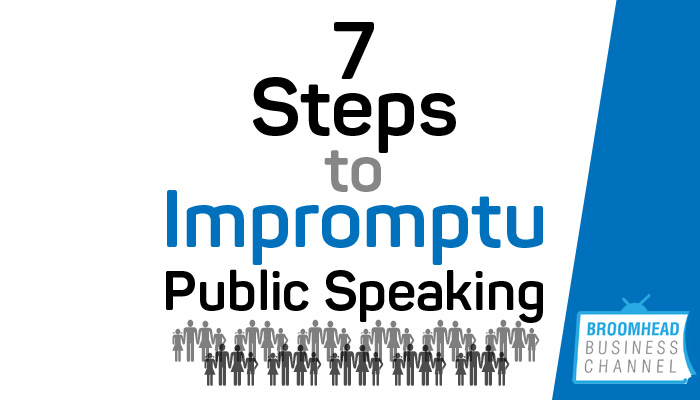
I think you will agree that most people are fearful of public speaking. There are different types and I personally think the hardest type is stand-up comedy. Therefore I recommend every leader to attend a quality comedy course and perform a 5-10 minute gig. Not so that you can crack a joke at your next AGM in front of the shareholders, (even though a little carefully crafted light humour can be helpful). It is more that once you have managed to remember your act word perfect and perform it to 80 strangers that have paid to be entertained by you, in a location such as the MAC Hexagon theatre, then most other speaking contexts will appear much easier.
The next type of public speaking that is the most challenging is impromptu. You may arrive at an event or at work and for whatever reason someone comes up to you and asks you to say a few words about an individual to a group. May be a team member is leaving the department, or someone has made a particular noteworthy achievement.
You have been given very little time to think it through. Perhaps 15 minutes maximum. So what are you going to do apart from get very nervous?
Wing it? Not advisable because that very rarely pays off.
What if you were to have a 7 step guide to impromptu public speaking? Would that benefit you?
Ok. Here is something I picked up when I was vice-president of Birmingham International Speakers Club. Not sure of the original source. Taking time to think what you are going to say and make some brief notes will prove invaluable:
- Prepare.
- Pen & Paper. Write your thoughts down onto A6 address card(s).
- Find a quiet place to consider and complete the following.
- Think of your view/stance/position and then summarise it.
- Think of a significant, relevant event (interesting or funny if appropriate) i.e. “I can remember when…”
- Think of the potential future for the person and/or organisation.
- Make brief notes of points 4, 5 and 6. Then smile, and using your written notes go give a memorable and noteworthy speech!
For lots more useful ideas and suggestions on Public Speaking and Leadership, then visit my Blog at http://www.matthewbroomhead.co.uk/broomhead-blog-posts/
Matthew Broomhead
Permanent link to this article: http://www.matthewbroomhead.co.uk/7-steps-to-impromptu-public-speaking/
I don’t have the time…
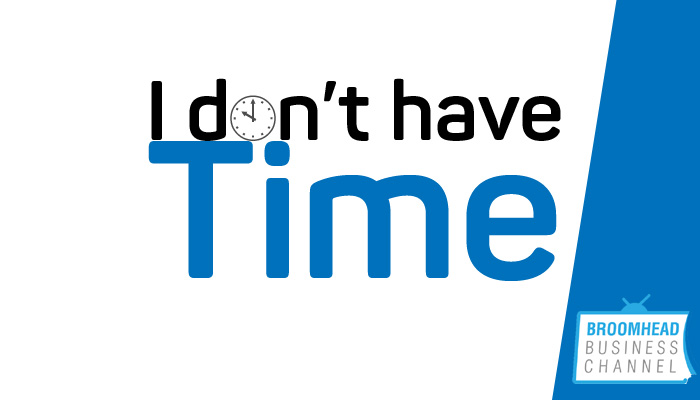
You know how most people would prefer if their careers were a little more fulfilling; or they could spend more time with their family; or have more enjoyable experiences with their friends? Well, would it be ok if I shared with you a simple insight to help you get more of what you want?
Most of my articles, blog posts, skill sessions and talks may be considered Common Sense. However, there is an old saying that “the problem with Common Sense is that it isn’t that common.”
What is the one thing that all of us have in common with the people that we admire for their achievements and success?
We did not have the same education, family and friends growing up or experiences of work, but we do all have one thing in common. There is the obvious biological aspects such as a heart, a brain, blood etc that we all need, but what I want to explore with you is the one thing that you and I have and is exactly the same as Richard Branson and Deborah Meadon.
So what is it?
The answer is 168.
168 is the number of hours in a week.
What differentiates the people that make a positive impact to those around them is how they spend those 168 hours. Remember you cannot “manage time”, you can only prioritise and spend it.
Let us spend a few of your precious minutes looking at and simplifying your week.
If we sleep 8 hours a day, work and commute 10 hours a day for 5 days and prepare and eat three meals a day what does that add up to?
Total : 168
Sleep : 56
Work : 50
Eat : 22 [7 days x 3 one hour meals + one extra hour]
Remaining : 40
40 hours a week left! We could get ourselves another full time job!
The challenge is that we fill a lot of that time with things that help us feel better in the short term. For example, the average person in the UK watches 28 hours of TV a week. Apparently this figure is reducing, but not because we are learning new skills and starting our own businesses to compensate for the massive short fall in pensions provision when we are older. I am afraid not. Apparently it is because we have replaced one very large screen attached to the wall with a smaller mobile screen and spending the time on social media.
I completely understand that we do not have 40 hours spare every week. Those of us with children are juggling all sorts of things and also there are those of us that are looking after elderly relatives, which will only increase as we live longer.
However, in the future let us not kid ourselves by saying we do not have the time. We all have 168 hours every week. The reality is more likely that we are not doing the important things that we know we should do because we have not prioritised properly; maybe we are scared of the unknown; perhaps we have a fear of failing; or we are unsure to uncover the true talents we have to share with the world.
So next time you hear yourself or someone say the following, then maybe think again.
“I don’t have the time!”
“Well actually, that is all we have!”
Matthew Broomhead
Permanent link to this article: http://www.matthewbroomhead.co.uk/i-dont-have-the-time/
Briefly “What is a Brand?”

Most people know brand is important to the success of an organisation. However, many freelancers, employees and even Marketing people do not know what it really is in a connection economy and the impact it will have on the overall success of an organisation.
In this short Article I thought I would share with you two influential businessmen’s views on brand. If you can answer the questions succinctly and in an engaging and meaningful way then your organisation will be significantly ahead of its competition.
1) “What is a brand?”
Seth Godin suggested the following:
A brand is not a logo. It is not a name. A brand is a series of expectations based on the promises you have made.
This is who we are, these are the promises we make.
Therefore what do you say to people about your organisation, so that they say to themselves, “oh that’s for me”.
2) Positioning
In an interview with Success Magazine, Nido Qubein who is a businessman and President of the fascinating High Point University, talked about the following:
“We need to position ourselves in a way that people will want to do business with us”. So I invite you to consider these three things to ask ourselves:
- Why should someone do business with me?
- How easily can someone else imitate me and do what I do?
- If someone was in the marketplace to buy, then would they think of me first and want to buy from me?
As with all good ideas they seem simple on the face of it, but are worth taking a little time to think through properly.
While you start to consider your answers to these questions relating to your Brand, then let me leave you with a quote from Nido:
“For the Timid, CHANGE is Frightening.
For the Comfortable, CHANGE is Threatening.
For the Confident, CHANGE is Opportunity.”
Matthew Broomhead
Permanent link to this article: http://www.matthewbroomhead.co.uk/briefly-what-is-a-brand%e2%80%8b/
Create an “Environment of Excellence”
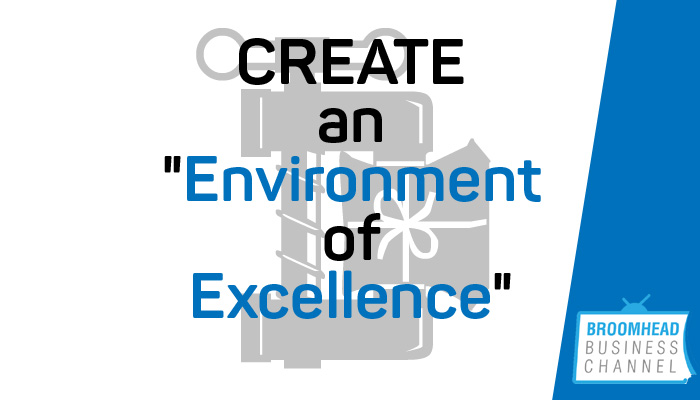
Most people think that they could be more successful if they made a few simple changes. The interesting thing is that most of us know what those changes are and yet have difficulty doing what is required. Even though success means different things to different people, there will need to be 7 key elements present.
- Learning the relevant skills
- Practicing those skills
- Implementing them by taking action
- Consistency of application
- Feedback awareness
- Adaptation
Sadly most of us don’t even know that we need to develop each of these six elements. They are each individual skill sets in their own right and take conscious effort. However, these six crucial elements may not be enough to ensure long term and high levels of success in the areas where you want to make an impact and in the lives you want to help change. There is another element, the seventh that I have described as an “Environment of Excellence“.
Matthew Syed was the former UK Table Tennis champion for 10 years. Around the time that Matthew developed, he said that half the top players in the country didn’t just come from the same region or town. They apparently lived in the same street as he did. When he looked at the contributing factors to their success there were these three primary observations:
- According to Matthew the coach at the sports club was probably the best in the country at that time.
- They had keys to the local sports club with 24 hour access. They could practice whenever they wanted and so they did. Spending their evenings, weekends and holidays honing their skills.
- The two factors above created a number of young people keen to develop their Table Tennis skills, which then naturally created a competitive group of highly skilled people to play against and inevitably get better.
The likelihood of success is massively increased by having a clear goal outcome and the desire to succeed; facilities to execute the action; a peer group of supportive and competitive people to help you grow and ongoing coaching from a professional that is one of the best in their field to inspire and unlock the potential in you. Sounds all rather obvious, but not always that simple to find in our work contexts. We have to be prepared to go and search for it.
The bestselling Author and journalist Malcom Gladwell has written and talked about these unusual environments that create excellence. His examples include:
- Some of the very wealthy mergers and acquisition law firms in the USA. Their owners were Jewish lawyers that went into that field of law decades ago as it was seen as unfavourable to most of the other firms that didn’t see the value in doing it at the time. I believe that due to discrimination they had difficulty obtaining other legal work so M&A was an ideal solution. Then in more recent times complex mergers and acquisitions became some of the most lucrative legal work available, which placed them in the perfect position to take full advantage.
- He also explored Bill Gates of Microsoft who had unprecedented access to a computer terminal overnight at his school as a child. There were only a few terminals in the whole of the country that were connected to a particular mainframe computer. It so happened that one was in Bill’s school. But also Bill was unusual in that, unlike most teenage boys, he would voluntarily get up in the middle of the night to travel across town and spend a few hours programming on this terminal.
- Steve jobs of Apple was born at a similar time to Bill when computers were just starting to evolve. If they had been born a decade earlier or later, then they wouldn’t have been “in the right place at the right time” and had the global success in those particular fields.
- Malcolm Gladwell talks about his own experience where his flat mate happened to be one of the most connected people in his city, which led to Malcolm getting a job in journalism which was his first step towards his success later in life.
Environments of Excellence are created by the decade we were born in, the family that raised us, the education we had, the people we happen to meet etc. Hence, a few people are fortunate that “all their stars are lined up”.
But, for the vast majority of us then we have a simple choice. To declare that we are not the lucky ones or we will decide to create our own Environments of Excellence.
Isn’t creating the conditions in which ordinary people can become extraordinary is what school and work should be about?
Matthew Broomhead
Permanent link to this article: http://www.matthewbroomhead.co.uk/create-an-environment-of-excellence/


